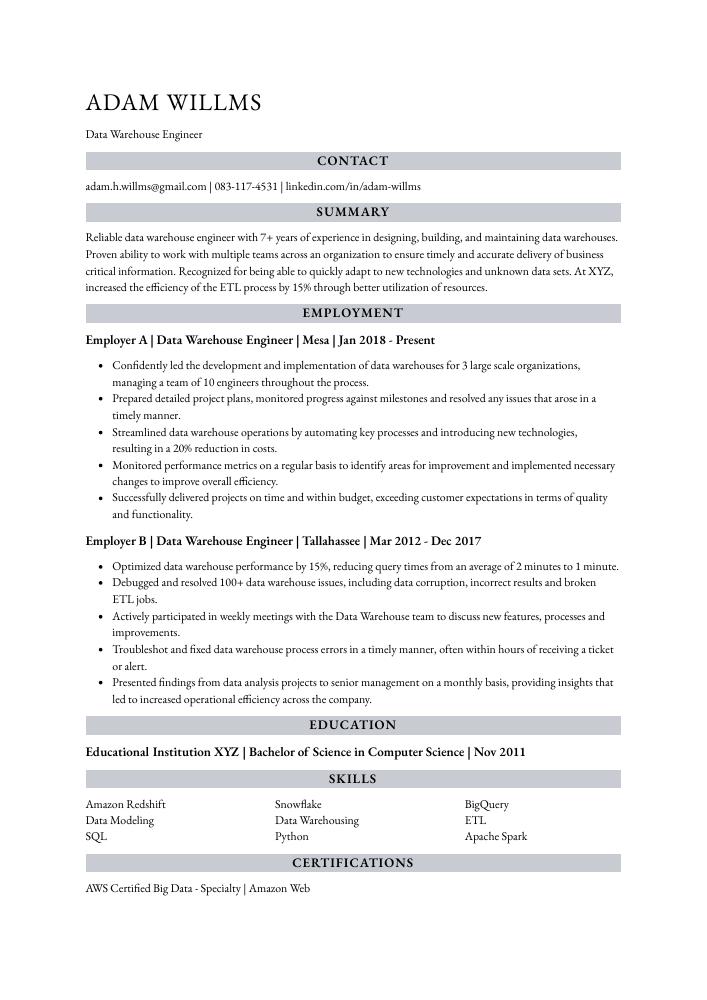Data Warehouse Engineer Resume Guide
Data warehouse engineers design, develop and maintain data warehouses that store large amounts of structured and unstructured data. They are responsible for managing the architecture, implementation and maintenance of databases to ensure maximum efficiency when retrieving information from them. Additionally, they create reports based on the stored data which can be used by various departments or organizations to make important decisions.
You have the technical knowledge and experience to be a data warehouse engineer at any company. But employers won’t know about your abilities until you write an outstanding resume that highlights them.
This guide will walk you through the entire process of creating a top-notch resume. We first show you a complete example and then break down what each resume section should look like.
Table of Contents
The guide is divided into sections for your convenience. You can read it from beginning to end or use the table of contents below to jump to a specific part.
Data Warehouse Engineer Resume Sample
Ottis Carroll
Data Warehouse Engineer
[email protected]
412-420-1180
linkedin.com/in/ottis-carroll
Summary
Seasoned data warehouse engineer with 8+ years of experience designing, developing and managing data warehouses for a wide range of organizations. Skilled in all aspects of the development cycle from design to implementation, including ETL processes and database optimization. Proven track record creating intuitive dashboards that improve decision making. Committed to leveraging my technical skillset and collaborative mindset to drive meaningful business results at XYZ company.
Experience
Data Warehouse Engineer, Employer A
Arlington, Jan 2018 – Present
- Implemented data warehouse solutions utilizing ETL processes, SSIS packages and database triggers to generate daily/weekly/monthly reports; increased data analysis efficiency by 40%.
- Represented the organization in a number of industry events and conferences related to Data Warehousing, promoting new technologies & strategies for efficient data storage solutions.
- Transformed raw datasets into meaningful information using complex SQL queries and stored procedures; created 5+ databases containing over 100 tables within 2 months of joining the team.
- Thoroughly tested all components of the DW architecture during system upgrades & migration projects, ensuring that there were no errors or downtime issues post-implementation; reduced technical glitches by 30%.
- Loaded millions of records from external sources into the DW repository with high accuracy levels (95%+) on a weekly basis; decreased manual labor hours involved in loading process by 25%.
Data Warehouse Engineer, Employer B
Oceanside, Mar 2012 – Dec 2017
- Advised the development team on the best data warehousing solutions to improve scalability and performance, resulting in a 20% reduction in query response times.
- Streamlined existing data warehouse architecture by re-designing ETL processes using SQL Server Integration Services (SSIS), thereby increasing efficiency by 30%.
- Effectively maintained and managed all components of the enterprise data warehouse system; resolved more than 100 queries within 2 hours each day for users across multiple departments.
- Analyzed source systems to identify new sources of structured & unstructured information that could be included into the warehouse; improved accuracy of reporting metrics by 60%.
- Formulated strategies for integrating disparate databases from various business units into one centralized location, reducing manual labor time spent cleaning up inaccurate datasets by 40%.
Skills
- SQL
- ETL
- Data Modeling
- Data Warehousing
- Data Visualization
- Business Intelligence
- Big Data
- Cloud Computing
- Data Mining
Education
Bachelor of Science in Computer Science
Educational Institution XYZ
Nov 2011
Certifications
Certified Data Warehouse Professional
Data Warehouse Institute
May 2017
1. Summary / Objective
Your resume summary or objective should be a concise, yet compelling statement that gives the hiring manager an overview of your data warehouse engineering experience and skills. Here is where you can showcase your best qualities; for example, mention the ETL tools you are proficient in using, any certifications or awards related to data warehousing that you have earned recently, and how you successfully implemented a new system at your current company.
Below are some resume summary examples:
Passionate data warehouse engineer with 6+ years of experience in designing, developing and deploying data solutions. Experienced in building high-performance systems that can handle large amounts of data quickly and efficiently. Proven track record for increasing customer satisfaction by streamlining processes and implementing new technologies to improve accuracy and efficiency. Seeking a position at ABC Tech where I can leverage my expertise to drive positive change.
Detail-oriented data warehouse engineer with 5+ years of experience developing solutions for enterprise-level data storage and ETL. Experienced in handling large volumes of data, implementing dimensional modeling techniques, and creating SQL queries to extract actionable insights from raw datasets. At XYZ Corp., successfully designed a system that allowed the company to capture over 1 million customer records daily while improving overall query performance by 30%.
Dependable data warehouse engineer with 5+ years of experience in designing and developing data warehouses. Adept at using ETL tools to extract, transform, and load data from multiple heterogeneous sources into the centralized repository. Experienced in creating a unified system for business analytics by combining different sources of structured/unstructured information. Successfully designed and implemented two high-performing DWs yielding cost savings of 15%.
Energetic and experienced data warehouse engineer with 8+ years of experience in designing and implementing large-scale enterprise data warehouses. Skilled at working on multiple projects simultaneously, demonstrating strong problem solving skills to quickly identify issues and develop solutions. Successfully led the design, development, implementation and maintenance of several high-performance data warehousing systems for Fortune 500 companies.
Well-rounded data warehouse engineer with 8+ years of experience designing, developing and deploying data warehouses for enterprise-level companies. Extensive knowledge in ETL processes, database architecture and optimization techniques. Achieved a 50% reduction in processing times by leveraging Big Data technologies such as Hadoop & Spark. Seeking to join ABC Tech to leverage my skillset for their data warehouse initiatives.
Reliable data warehouse engineer with 5+ years of experience designing, developing and maintaining data warehouses for organizations. Skilled in ETL process management and end-to-end system architecture design. Seeking to join ABC to leverage expertise in transforming raw data into meaningful insights that drive business decisions. Improved performance by 15% through development of automated processes at XYZ Corp.
Professional data warehouse engineer with 7+ years of experience designing and building data warehouses for large-scale companies. Proven track record in developing complex ETL processes, performing SQL queries, and optimizing database performance to enable faster insights. Looking to join ABC Corp as a Data Warehouse Engineer where I can use my skillset to develop reliable solutions that drive business success.
Proficient data warehouse engineer with 7+ years of experience in design, development, and implementation of data warehouses. Proven track record in building high-performance ETL pipelines to automate business processes while maintaining top-notch security standards. Committed to join ABC Tech as a Data Warehouse Engineer and leverage my skillset towards their mission critical projects.
2. Experience / Employment
In the experience/employment/work history section, you should list your professional history in reverse chronological order. This means that the most recent job is listed first, followed by previous positions.
When writing this section, it’s best to stick with bullet points so that readers can quickly digest what you have to say. You want to provide detail on each role and any quantifiable results achieved while doing them.
For example, instead of saying “Managed data warehouse,” you could say, “Designed a data warehouse architecture using Amazon Redshift which resulted in an 80% reduction in query time.”
To write effective bullet points, begin with a strong verb or adverb. Industry specific verbs to use are:
- Designed
- Implemented
- Optimized
- Monitored
- Administered
- Developed
- Extracted
- Transformed
- Loaded
- Validated
- Analyzed
- Troubleshot
- Automated
- Documented
- Secured
Other general verbs you can use are:
- Achieved
- Advised
- Assessed
- Compiled
- Coordinated
- Demonstrated
- Expedited
- Facilitated
- Formulated
- Improved
- Introduced
- Mentored
- Participated
- Prepared
- Presented
- Reduced
- Reorganized
- Represented
- Revised
- Spearheaded
- Streamlined
- Structured
- Utilized
Below are some example bullet points:
- Reorganized a complex data warehouse for a national retail chain, resulting in an increase of 10% in query efficiency.
- Validated and tested hundreds of ETL processes to ensure data accuracy and integrity; identified & corrected errors which saved over $2,500 in labor costs.
- Coordinated with stakeholders from multiple departments to identify key areas of improvement related to the design and development of the data warehouse structure.
- Spearheaded projects that improved scalability by 25%, allowing more effective storage, retrieval & reporting capabilities across large datasets without compromising system performance or speed.
- Independently handled end-to-end troubleshooting related to database queries using SQL & PL/SQL programming languages; decreased resolution time by 20%.
- Automated data warehouse processes and ETL jobs, resulting in a 25% increase in data processing speed.
- Demonstrated sound knowledge of SQL queries by revising over 500 stored procedures and improving query execution performance by 20%.
- Presented weekly progress reports to the Data Warehouse Manager on development efforts; identified opportunities for process optimization which increased overall efficiency by 40%.
- Revised system architecture design documents to ensure that new applications were compatible with existing structure while maintaining high security standards throughout the organization’s IT environment.
- Confidently supported hundreds of users across multiple sites with their data integration needs, resolving issues within 2 hours on average per request.
- Resourcefully designed and implemented a data warehouse structure to accommodate up to 5 terabytes of data, resulting in an 80% increase in storage capacity.
- Achieved optimal performance for the ETL (Extract Transform Load) process by developing scripts that automated the flow of ingested data from source systems into target databases; saved over 30 hours per month on manual labor.
- Administered SQL Server Integration Services (SSIS), SSRS, SSAS & PowerBI toolsets to generate insights from structured, semi-structured & unstructured datasets; reduced time spent analyzing information by 60%.
- Prepared complex queries using T-SQL language and stored procedures while adhering strictly to industry standards; improved query execution times by 45%.
- Compiled reports detailing key business metrics such as revenue growth quarter-over-quarter and customer segmentation trends with Tableau visualization software within 2 days of request deadline completion rate of 95%.
- Reliably managed the design, development and implementation of data warehouses for 7+ clients; reduced complexity by 15% while increasing accuracy by 20%.
- Mentored 3 junior engineers in developing ETL processes to extract, transform and load data from various sources into a centralized warehouse.
- Reduced redundant codes by 10%, improved system performance metrics such as query optimization & database indexing efficiency, resulting in an overall 25% faster loading time for databases.
- Expedited troubleshooting process for database issues up to 50%; upgraded existing systems with new features to meet customer needs more effectively within 2 weeks’ timeline on average per project.
- Participated actively in business intelligence initiatives such as predictive analysis projects across 6 divisions of the company; successfully completed 5 projects over a period of 9 months ahead of schedule.
- Improved data warehouse performance by 70% through efficient data modeling and optimization of code.
- Extracted large volumes of customer, sales, and inventory data from multiple sources to create a unified database environment for analytics purposes.
- Assessed existing systems architecture to identify areas in need of improvement; developed new strategies that streamlined operations and improved accuracy/efficiency by 20%.
- Facilitated communication between IT staff members on the development team to ensure proper integration among all components within the warehouse system infrastructure.
- Consistently monitored data integrity across multiple databases on a daily basis, ensuring no errors or discrepancies existed prior to uploading into the main repository (+55 entries per day).
- Utilized SQL and data warehouse technologies to design, maintain, and optimize over 50 databases for a variety of enterprise systems; reduced query run time by 30% through the implementation of indexing techniques.
- Structured large amounts of data from multiple sources into logical schemas that could be used across different business applications; improved user access to information by 45%.
- Proficiently managed ETL processes using tools such as SSIS and Informatica PowerCenter for timely data loading into the warehouses; minimized delivery duration delays by 25%.
- Troubleshot issues related to database performance, scalability & security in order to ensure high availability & integrity while supporting end users with their queries during peak usage times.
- Monitored server resources (CPU/memory utilization) proactively on an ongoing basis in order to identify any potential problems before they occurred; decreased system downtime incidents by 40%.
- Documented processes and procedures related to data warehouse designs, implementations and operations; resulting in a 40% reduction in delivery time for new projects.
- Secured sensitive customer data by developing robust backup systems & encryption protocols tailored to the needs of major clients such as XYZ Corporation & ABC Bank.
- Developed complex ETL processes that integrated internal & external sources into multiple warehouses with over 1 TB worth of structured/unstructured datasets combined together; lowered error rates from 15% to 3%.
- Optimized existing query performance by upskilling team members on advanced SQL optimization techniques, increasing overall output speed by 35%.
- Competently managed large-scale migrations between different databases (e. G Oracle -> MySQL) while maintaining strict process control standards throughout the entire migration period (+30 days).
3. Skills
Even though two organizations are hiring for the same role, the skillset they want an ideal candidate to possess could differ significantly. For instance, one may be on the lookout for an individual with experience in Apache Hadoop, while the other may be looking for someone who is proficient in Amazon Redshift.
The skills section of your resume should reflect this by being tailored to each job you are applying for. This will help ensure that applicant tracking systems (computer programs used to scan resumes) pick up on all the right keywords and pass it along to a human recruiter or hiring manager.
In addition, you can further elaborate on these skillset by discussing them in more detail within other sections such as the summary or work experience portion of your resume.
Below is a list of common skills & terms:
- Big Data
- Business Intelligence
- Cloud Computing
- Data Analysis
- Data Mining
- Data Modeling
- Data Visualization
- Data Warehousing
- ETL
- SQL
4. Education
Mentioning an education section on your resume will depend on how much experience you have in the field. If you are new to data warehouse engineering and don’t have any work experience, it is important to include an education section below your resume objective. On the other hand, if you already have significant industry experience that speaks for itself, omitting this section may be best.
If including an education section, try to mention courses related to data warehousing and databases as well as relevant technical certifications or degrees that demonstrate your knowledge of the subject matter.
Bachelor of Science in Computer Science
Educational Institution XYZ
Nov 2011
5. Certifications
Certifications are a great way to demonstrate your knowledge and expertise in a particular field. They can help you stand out from other applicants, as they show that you have been tested by an accredited organization and are proficient in the skill or area of study.
When applying for jobs, be sure to include any certifications relevant to the position on your resume. This will give hiring managers assurance that you possess the necessary skillset for the role.
Certified Data Warehouse Professional
Data Warehouse Institute
May 2017
6. Contact Info
Your name should be the first thing a reader sees when viewing your resume, so ensure its positioning is prominent. Your phone number should be written in the most commonly used format in your country/city/state, and your email address should be professional.
You can also choose to include a link to your LinkedIn profile, personal website, or other online platforms relevant to your industry.
Finally, name your resume file appropriately to help hiring managers; for Ottis Carroll, this would be Ottis-Carroll-resume.pdf or Ottis-Carroll-resume.docx.
7. Cover Letter
Cover letters are an essential part of the job application process. They provide a great opportunity to expand on information mentioned in your resume and give recruiters an insight into who you are as a professional.
A cover letter should be made up of 2 to 4 paragraphs, each one adding value to your application. It’s important that it is tailored specifically for the role you’re applying for so that hiring managers can see why you’d make a great fit for their company.
Below is an example cover letter:
Dear Melisa,
I am writing in response to your posting for a Data Warehouse Engineer. With my experience designing and managing data warehouses, as well as my background in developing ETL processes, I am confident I can be an asset to your organization.
In my current role at [company name], I manage a team of five engineers who are responsible for developing and maintaining our data warehouse. We use a variety of tools and platforms, including Hadoop, Hive, Spark, and Teradata, to store and process our data. In addition to overseeing the day-to-day operations of the team, I also design new ETL processes and work on improving existing ones.
One of the projects I’m most proud of is the implementation of a real-time streaming data pipeline that ingests millions of events per day from our website and mobile applications. This has been instrumental in helping us make better decisions about how to improve our products and services.
I believe my skills and experience would be a valuable addition to your team. I am eager to put my knowledge to work in order to help you achieve your business goals. If you have any questions or would like more information about my qualifications, please do not hesitate to contact me at [phone number] or [email address]. Thank you for your time; I look forward to hearing from you soon!
Sincerely,
Ottis
Data Warehouse Engineer Resume Templates
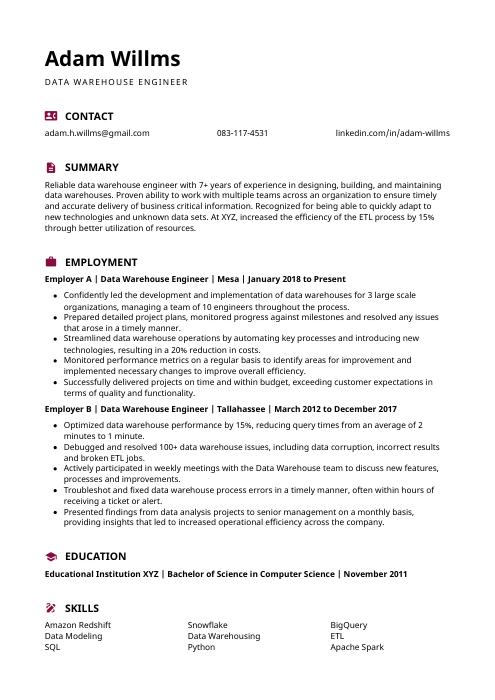 Hoopoe
Hoopoe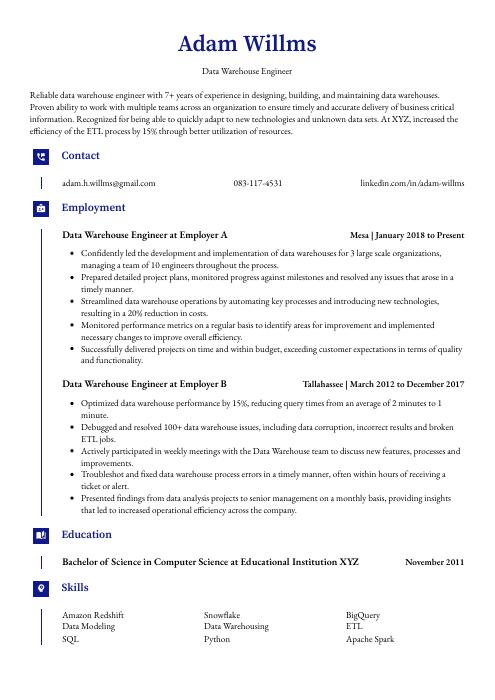 Gharial
Gharial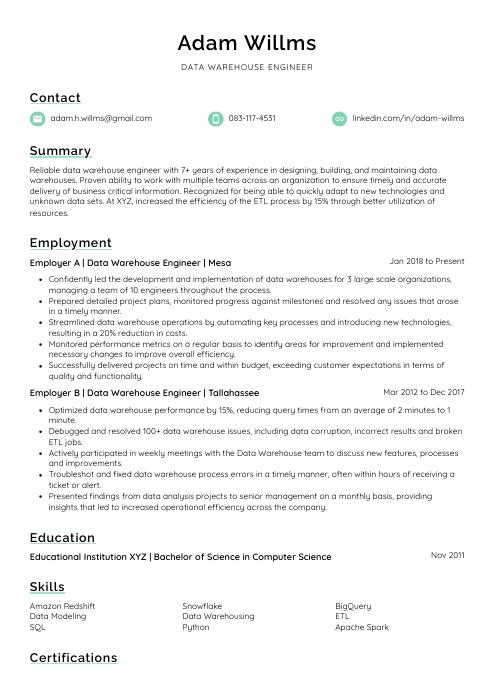 Lorikeet
Lorikeet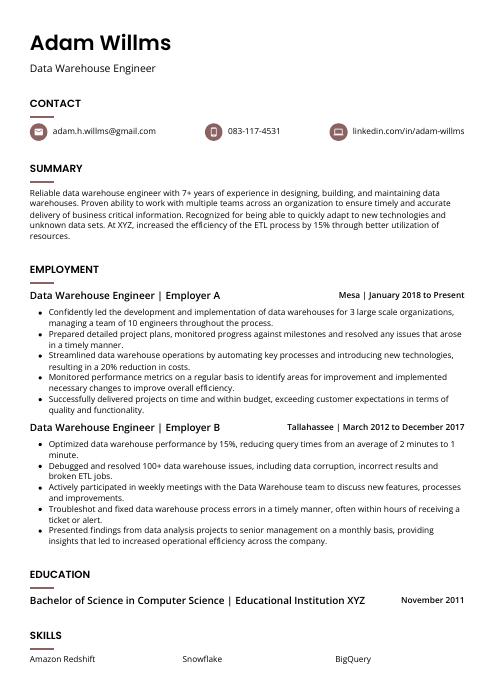 Fossa
Fossa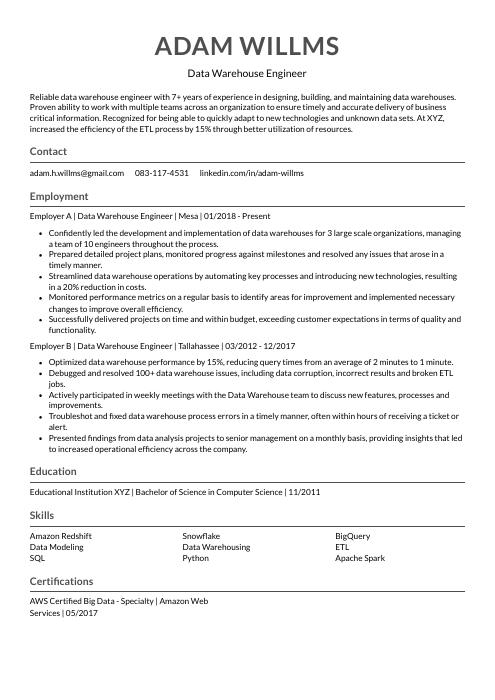 Indri
Indri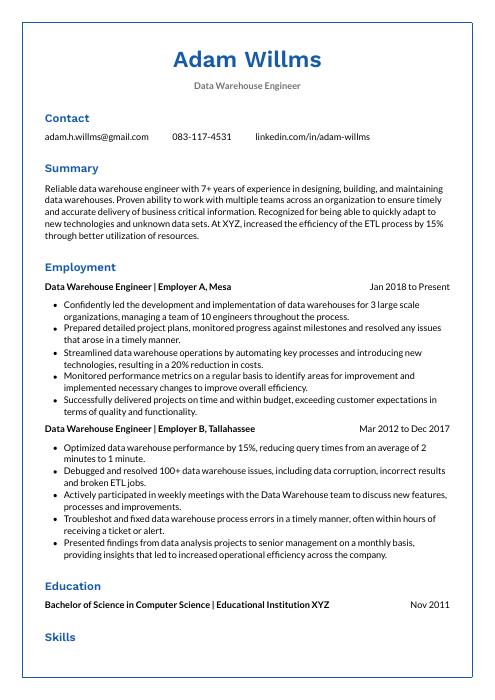 Markhor
Markhor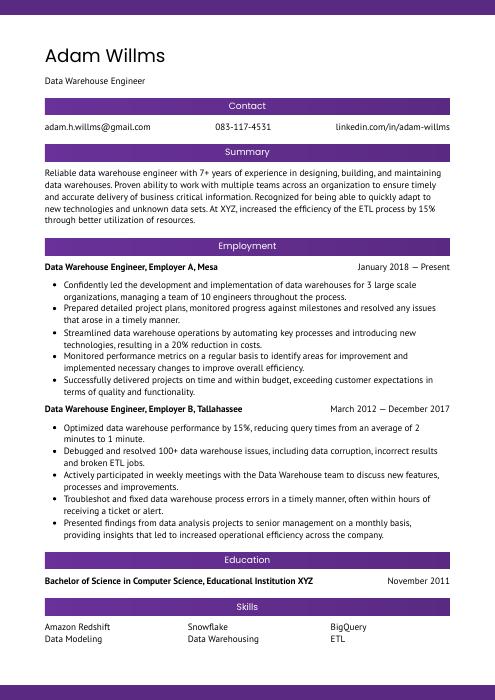 Jerboa
Jerboa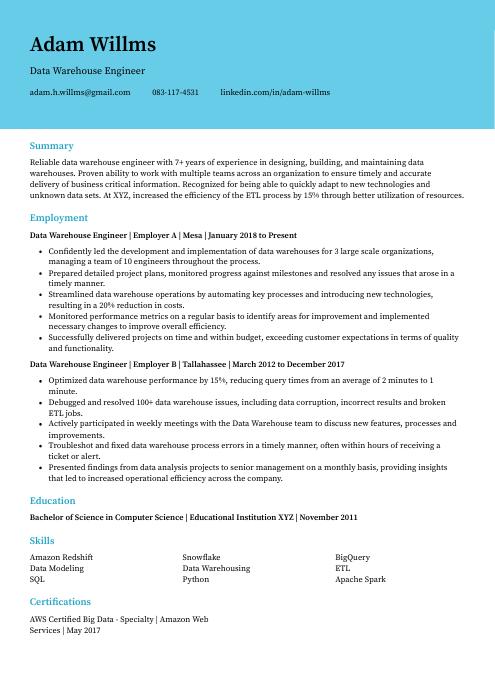 Dugong
Dugong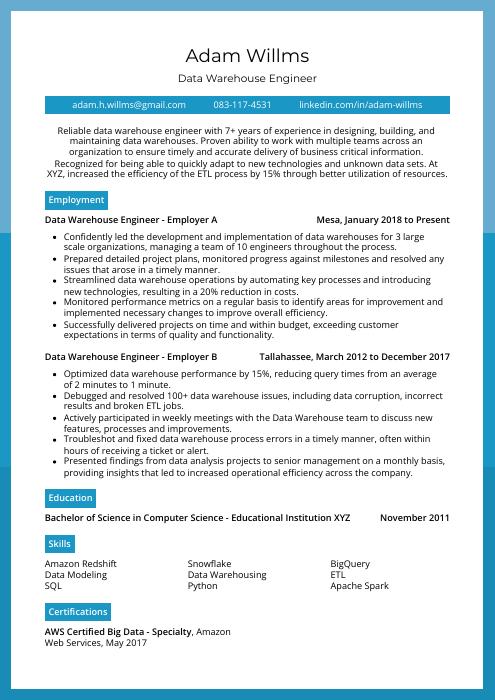 Rhea
Rhea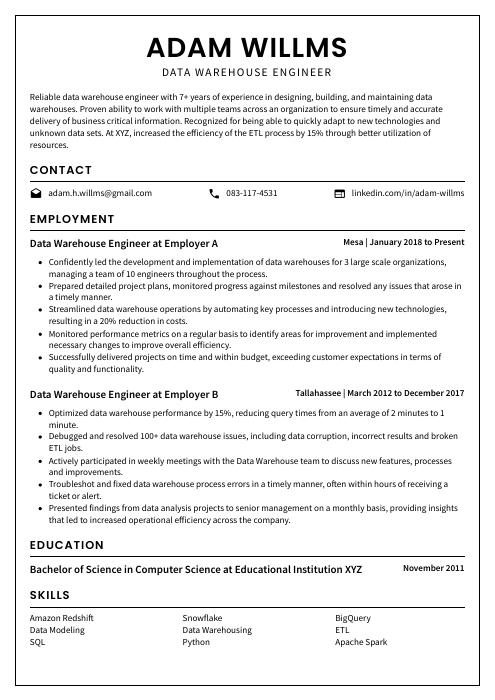 Cormorant
Cormorant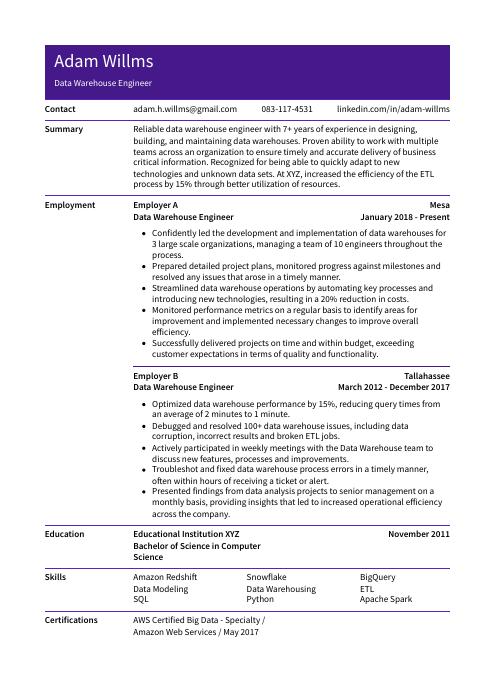 Pika
Pika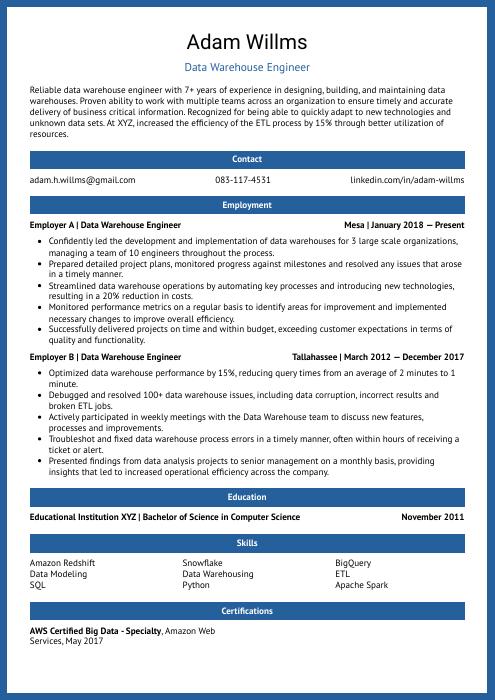 Ocelot
Ocelot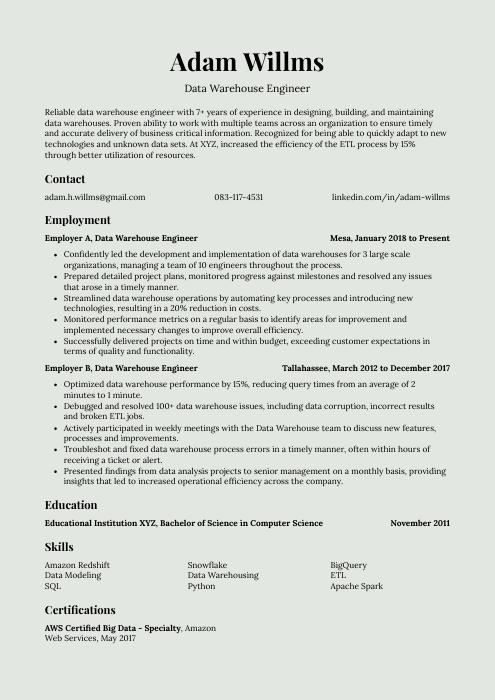 Saola
Saola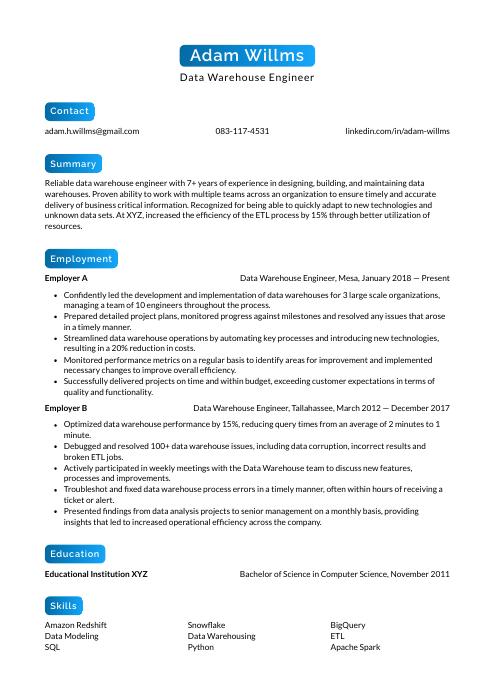 Kinkajou
Kinkajou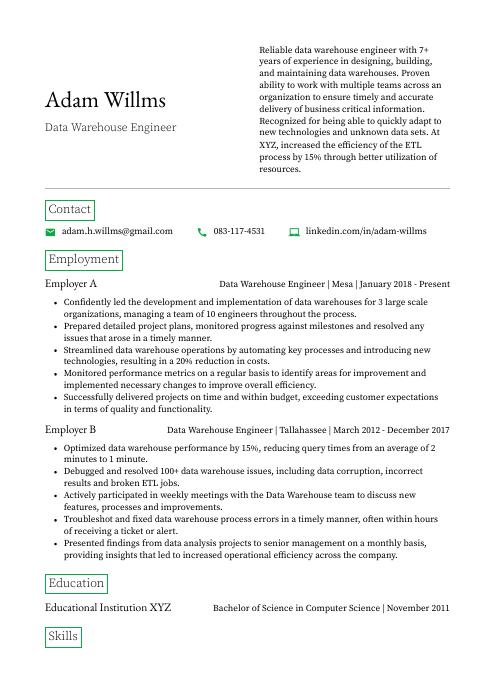 Quokka
Quokka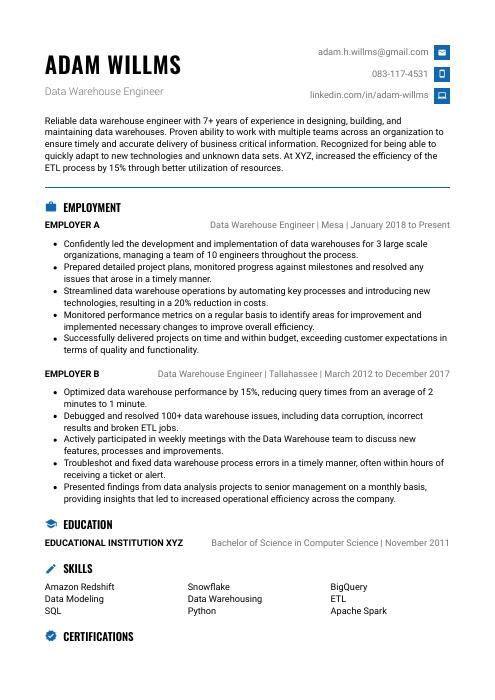 Echidna
Echidna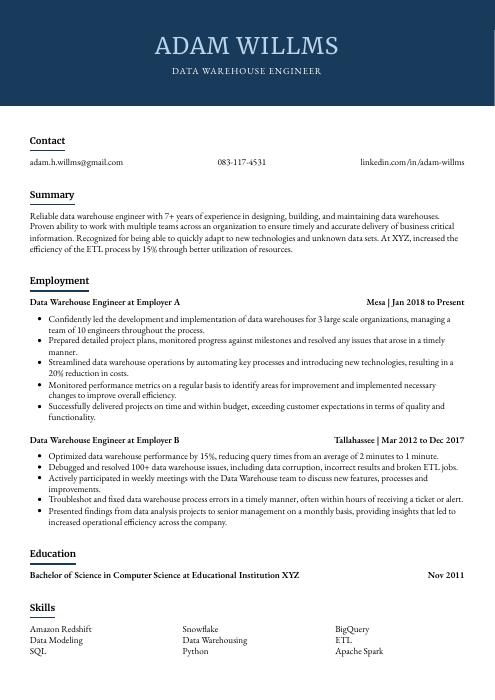 Bonobo
Bonobo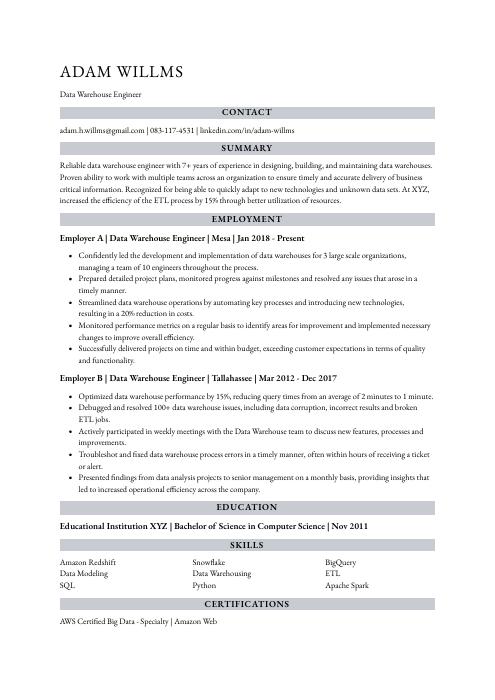 Numbat
Numbat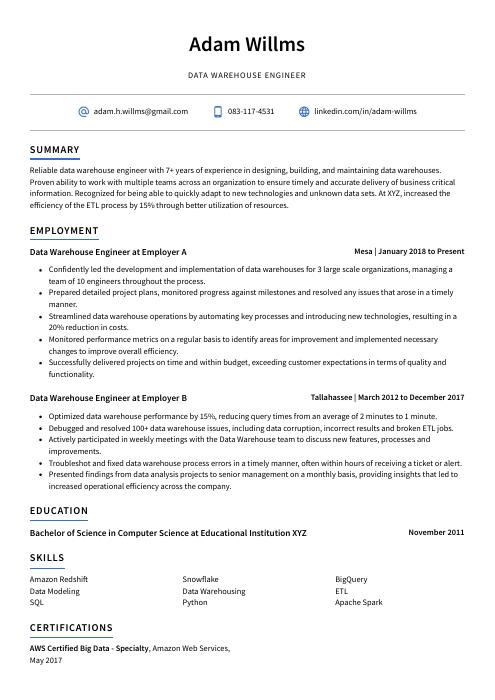 Axolotl
Axolotl Rezjumei
Rezjumei
